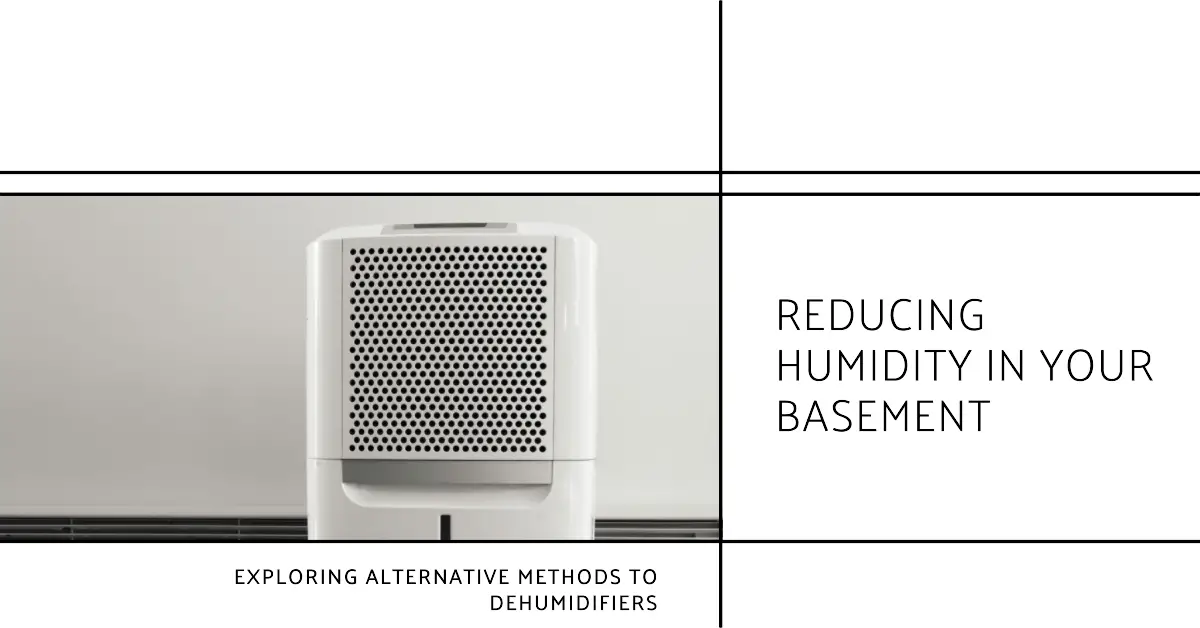I am a well-rounded expert with proficiency in several fields. My experience spans from being a dedicated chef and homemaker. As a passionate homesteader, I’ve honed my skills in sustainable living and animal care, ensuring a holistic approach to everything I undertake. Email me or Txt: (# removed due to spam, please email)
When it comes to controlling humidity in your basement, a dehumidifier is often the go-to solution. However, there are alternative methods that can help you reduce humidity levels and maintain a comfortable, healthy environment.
In this article, we’ll explore how fans, improved ventilation, and other tactics can help you manage basement humidity without relying solely on a dehumidifier.

Using Fans to Reduce Humidity in Basements
Fans can be an effective way to control humidity in your basement. By increasing air circulation, they help to evaporate moisture and maintain a more consistent temperature.
There are several types of fans suitable for basements, including box fans, pedestal fans, and exhaust fans.
To maximize their effectiveness, place them strategically to promote cross-ventilation and run them on a regular basis, especially during periods of high humidity.
It’s important to note that while fans can help reduce humidity in basements, they may not be as effective in spaces with excessive moisture. In such cases, it’s essential to address the underlying issues causing the high humidity, such as water intrusion or poor ventilation.
Fans can increase energy consumption and may not be the most energy-efficient solution for humidity control. Consider complementary strategies, such as dehumidifiers or improved waterproofing, to achieve optimal basement humidity levels.

Reducing Humidity without a Dehumidifier
Aside from using fans, there are other methods for reducing humidity in your basement without relying on a dehumidifier. Some of these techniques include:
- Improving air circulation: Ensuring that air can flow freely throughout your basement will help to keep humidity levels in check. Remove any clutter or obstructions that may be blocking vents or air pathways.
- Absorbing moisture with desiccants: Desiccants, such as silica gel or calcium chloride, can help to absorb excess moisture in the air. Place them in strategic locations throughout your basement to help maintain a more balanced humidity level.
- Sealing and insulating the basement: Address any cracks or gaps in your basement walls, floors, and ceiling. This will help to prevent moisture from entering and accumulating in the space. Additionally, insulating your basement will help to regulate temperature and reduce condensation.
- Improving ventilation: Proper ventilation is crucial in reducing humidity levels. Installing exhaust fans or vents in your basement can help to remove humid air and bring in fresh, drier air from outside.
- Using a natural dehumidifier: Plants like Boston ferns, spider plants, and English ivy can help to naturally absorb excess moisture in the air. Be sure to choose plants that thrive in low-light conditions and are safe for pets.
- Controlling moisture sources: Address any sources of moisture in your basement, such as leaks, standing water, or condensation. Fixing these issues can help to reduce humidity levels and prevent further moisture buildup.
- Reducing water usage: High levels of indoor humidity can also be caused by excessive water usage in your home. Be mindful of how often you use appliances like washing machines, dishwashers, and showers, and try to reduce usage during humid weather. Even dryer put out an exceptional amount of humidity.
- Using a hygrometer: A hygrometer can help you monitor the humidity levels in your basement and determine whether additional steps are needed to reduce moisture levels.

The Importance of Ventilation in Humidity Control
Proper ventilation is crucial for maintaining a healthy humidity level in your basement. Ventilation helps to expel moist air and bring in fresh, dry air. There are two main types of ventilation methods:
- Natural ventilation: This involves opening windows and doors to allow fresh air to circulate. However, it may not be as effective in basements with limited window access or during times of high outdoor humidity.
- Mechanical ventilation: This includes exhaust fans, air exchangers, and other devices designed to promote air circulation. Mechanical ventilation systems are often more effective at reducing humidity in basements compared to natural ventilation methods.
To improve your basement’s ventilation, consider installing exhaust fans, air exchangers, or a combination of the two. Regularly inspect and clean your ventilation system to ensure optimal performance.

Additional Tips for Humidity Reduction in Basements
In addition to the methods mentioned above, there are a few more tips for managing humidity in your basement:
- Address water leaks and sources of moisture: Regularly inspect your basement for signs of water leaks or seepage, and promptly repair any issues you find.
- Maintain proper temperature and airflow: Keeping your basement at a consistent temperature and ensuring good airflow will help to minimize condensation and reduce humidity levels.
- Choose moisture-resistant materials for basement finishing: Opt for materials that are resistant to moisture and mold, such as moisture-resistant drywall or cement board, when finishing your basement.

Conclusion
Controlling humidity in your basement doesn’t always require a dehumidifier. By using fans, improving ventilation, and implementing other humidity-reducing strategies, you can maintain a comfortable and healthy environment.
Remember to monitor humidity levels regularly and adjust your approach as needed to achieve the best results.




